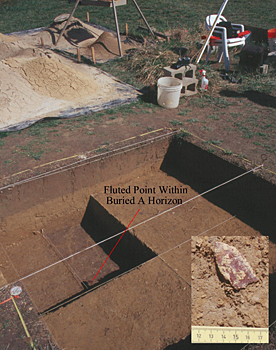
When UD doctoral student Darrin Lowery was 6, he and his father began collecting arrowheads and spearheads that they found along the shoreline of Tilghman Island in the Chesapeake Bay. “We found some interesting things, but we didn't know what they were,” Lowery said.
These artifacts remained interesting curiosities until the late 1970s when Lowery and his father were watching “The Search for the First American,” a television program about the first inhabitants of North America. During the broadcast, Dennis Stanford, chairperson of the National Museum of Natural History's anthropology department, showed a Clovis point, or fluted spearhead made of stone, used as a hunting tool at the end of the last ice age about 11,000 years ago and named after the first of its kind discovered in Clovis, N.M., in 1932. Clovis tools have rock spear points, are thin and bifacial and share "overshot" flaking characteristics that make wide, flat blades.
After watching the program, Lowery said he told his father he had Clovis points in his collection, but the senior Lowery was skeptical. “My father wondered why someone during the ice age was living on what is now Tilghman Island,” Lowery said. At that time, Clovis points were mostly found in the west, and anthropologists believed they were used by hunters who migrated from Siberia to Alaska across the Bering Strait.
Then, when Lowery was 13, he and his sister went to a conference in Washington, D.C., where Stanford was speaking. Lowery brought along his collection, and when he had the opportunity, he approached Stanford. Lowery said Stanford was astonished that these artifacts had been gathered in Maryland and began excavating on Tilghman Island almost immediately.
Stanford found that Tilghman Island's Clovis points were older than those found in New Mexico--about 2,000 years older. Since then, a site discovered more recently near Richmond, Va., has yielded Clovis points that may be 17,000 years old.

The Solutrean theory is based on the assumption that hunters, living in prehistoric Europe (now France and Spain) approximately 21,000-17,000 years ago, traveled to North America looking for game and brought their methods of making stone tools with them, providing the foundation for later Clovis technology found throughout North America. The theory rests on the similarities in Solutrean and Clovis tools that have no known counterparts before 11,200 in eastern Asia, Siberia or the Bering Strait.
While Lowery is still involved with the Tilghman Island excavation, his field of doctoral research in geological sciences at UD is geoarcheology. Under the supervision of Michael O'Neal, assistant professor of geography and geological sciences, Lowery is studying how landscape changes through time. That was the subject of his master's degree research at Temple University.
Lowery's interest is in how geological formations reveal weather patterns and how these weather patterns affect human development.
He said his excavations on Tilghman Island show evidence that around 12,900 years ago, it suddenly got really cold and dry. “In 20-50 years, it went from a mild climate to almost full glacial conditions. There were a lot of Clovis occupations before 13,000 years, but after that this area becomes a no-man's land,” Lowery said.
“In today's world we talk about global warming and cooling, but the best way to understand the impact of climate is to look at the past,” he said.

Excavations along the East Coast are revealing important information about the origins of the first Americans, especially, the 20-acre Tilghman Island site that Lowery once owned. He sold it to the Eastern Shore Land Conservancy, a private, nonprofit organization working for sound land-use planning on Maryland's Eastern Shore. The sale protected the site from development, securing it for archeological research.
Lowery said that the Tilghman Island site still has much to reveal, and now, its protected status will give scientists the time they need to dig deeper.
Article by Barbara Garrison
Photos courtesy of Darrin Lowery

